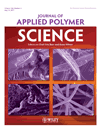Star-shape poly(acrylic acid)-composed glass-ionomer cements: Effects of MW and arm number on mechanical properties
Abstract
This study reports the synthesis and characterization of the star-shape poly(acrylic acid)s with different arm numbers and molecular weight (MW)s. The effects of arm number and initiator concentration on the atom-transfer radical polymerization reaction kinetics and solution viscosity were studied. The effects of MW and arm number on mechanical properties were evaluated. The results showed that both arm number and MW had significant impacts on the polymerization kinetics, solution viscosity, mechanical strengths, and wear-resistance. Decreasing arm number and increasing initiator concentration increased the reaction rate. Increasing arm number and initiator concentration decreased the solution viscosity. Decreasing arm number and increasing MW increased mechanical strengths and wear-resistance. Within the limitations of this study, the experimental cement was 28% in compressive strength, 48% in compressive modulus, 39% in diametral tensile strength, 60% in flexural strength, and 62% in Knoop hardness higher but 19% in fracture toughness lower than commercial Fuji II LC cement. The abrasion and attrition of the experimental cement were only 1.3% and 9.5% of Fuji II LC. © 2010 Wiley Periodicals, Inc. J Appl Polym Sci, 2011




